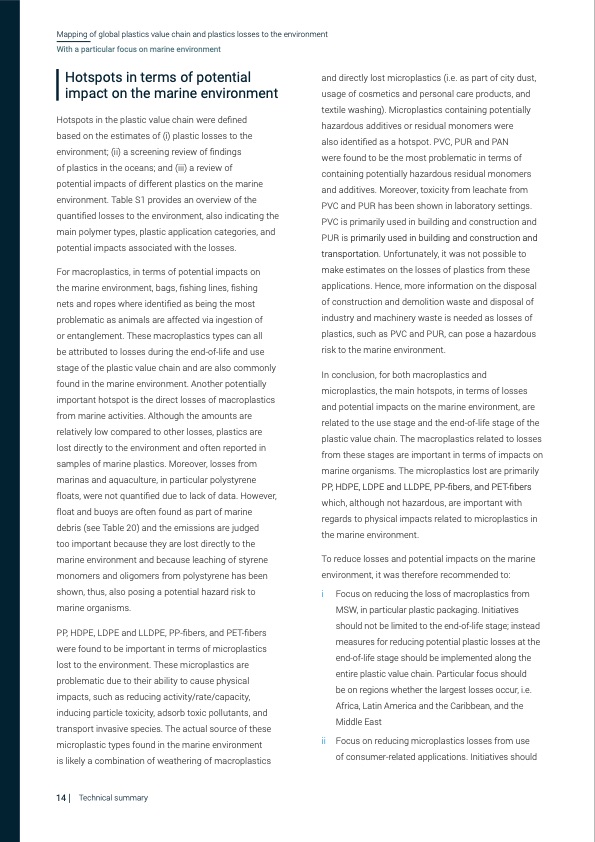
PDF Publication Title:
Text from PDF Page: 016
Mapping of global plastics value chain and plastics losses to the environment With a particular focus on marine environment | Hotspots in terms of potential impact on the marine environment Hotspots in the plastic value chain were defined based on the estimates of (i) plastic losses to the environment; (ii) a screening review of findings of plastics in the oceans; and (iii) a review of potential impacts of different plastics on the marine environment. Table S1 provides an overview of the quantified losses to the environment, also indicating the main polymer types, plastic application categories, and potential impacts associated with the losses. For macroplastics, in terms of potential impacts on the marine environment, bags, fishing lines, fishing nets and ropes where identified as being the most problematic as animals are affected via ingestion of or entanglement. These macroplastics types can all be attributed to losses during the end-of-life and use stage of the plastic value chain and are also commonly found in the marine environment. Another potentially important hotspot is the direct losses of macroplastics from marine activities. Although the amounts are relatively low compared to other losses, plastics are lost directly to the environment and often reported in samples of marine plastics. Moreover, losses from marinas and aquaculture, in particular polystyrene floats, were not quantified due to lack of data. However, float and buoys are often found as part of marine debris (see Table 20) and the emissions are judged too important because they are lost directly to the marine environment and because leaching of styrene monomers and oligomers from polystyrene has been shown, thus, also posing a potential hazard risk to marine organisms. PP, HDPE, LDPE and LLDPE, PP-fibers, and PET-fibers were found to be important in terms of microplastics lost to the environment. These microplastics are problematic due to their ability to cause physical impacts, such as reducing activity/rate/capacity, inducing particle toxicity, adsorb toxic pollutants, and transport invasive species. The actual source of these microplastic types found in the marine environment is likely a combination of weathering of macroplastics and directly lost microplastics (i.e. as part of city dust, usage of cosmetics and personal care products, and textile washing). Microplastics containing potentially hazardous additives or residual monomers were also identified as a hotspot. PVC, PUR and PAN were found to be the most problematic in terms of containing potentially hazardous residual monomers and additives. Moreover, toxicity from leachate from PVC and PUR has been shown in laboratory settings. PVC is primarily used in building and construction and PUR is primarily used in building and construction and transportation. Unfortunately, it was not possible to make estimates on the losses of plastics from these applications. Hence, more information on the disposal of construction and demolition waste and disposal of industry and machinery waste is needed as losses of plastics, such as PVC and PUR, can pose a hazardous risk to the marine environment. In conclusion, for both macroplastics and microplastics, the main hotspots, in terms of losses and potential impacts on the marine environment, are related to the use stage and the end-of-life stage of the plastic value chain. The macroplastics related to losses from these stages are important in terms of impacts on marine organisms. The microplastics lost are primarily PP, HDPE, LDPE and LLDPE, PP-fibers, and PET-fibers which, although not hazardous, are important with regards to physical impacts related to microplastics in the marine environment. To reduce losses and potential impacts on the marine environment, it was therefore recommended to: i Focus on reducing the loss of macroplastics from MSW, in particular plastic packaging. Initiatives should not be limited to the end-of-life stage; instead measures for reducing potential plastic losses at the end-of-life stage should be implemented along the entire plastic value chain. Particular focus should be on regions whether the largest losses occur, i.e. Africa, Latin America and the Caribbean, and the Middle East ii Focus on reducing microplastics losses from use of consumer-related applications. Initiatives should 14 | Technical summaryPDF Image | Mapping of global plastics value chain

PDF Search Title:
Mapping of global plastics value chainOriginal File Name Searched:
2018-plastics-global-hotspots.pdfDIY PDF Search: Google It | Yahoo | Bing
Development of a solar powered Electric Ship The Electricship website originally started off as a project to develop a comprehensive renewable, affordable, modular electric ship... More Info
Modular Boat Hull Composite The case for a unsinkable, modular composite hybrid boat hull... More Info
MS Burgenstock Hybrid Electric Catamaran Lake Lucerne Unique shuttle servicing Lucerne to the Burgenstock Resort... More Info
Ground Power Unit GPU Powered by Lithium Ion Batteries The goal of the Ground Power Unit is to provide a readily accessible, modular, ready-to-power solution for remote power... More Info
| CONTACT TEL: 608-238-6001 Email: greg@electricship.com | RSS | AMP |